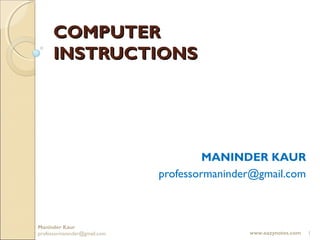
Computer instructions
- 1. COMPUTER INSTRUCTIONS MANINDER KAUR professormaninder@gmail.com Maninder Kaur professormaninder@gmail.com www.eazynotes.com 1
- 2. INSTRUCTION FORMAT An instruction format or instruction code is a group of bits used to perform a particular operation on the data stored in computer. Processor fetches an instruction from memory and decodes the bits to execute the instruction. Different computers may have their own instruction set. Maninder Kaur professormaninder@gmail.com www.eazynotes.com 2
- 3. INSTRUCTION FORMAT Instruction code is divided into two parts namely operation code and address of data. Operation code consisting group of bits to define an operation such as add, subtract, multiply etc. Maninder Kaur professormaninder@gmail.com www.eazynotes.com 3
- 4. INSTRUCTION FORMAT In an instruction format: First 12 bits (0-11) specify an address. Next 3 bits specify operation code (opcode). Left most bit specify the addressing mode I I = 0 for direct address I = 1 for indirect address Maninder Kaur professormaninder@gmail.com www.eazynotes.com 4
- 5. TYPES OF INSTRUCTIONS The basic computer has three 16-bit instruction code formats: 1. Memory Reference Instructions 2. Register Reference Instructions 3. Input/Output Instructions Maninder Kaur professormaninder@gmail.com www.eazynotes.com 5
- 6. Memory Reference Instructions In Memory reference instruction: First 12 bits(0-11) specify an address. Next 3 bits specify operation code (opcode). Left most bit specify the addressing mode I I = 0 for direct address I = 1 for indirect address (Opcode = 000 through 111) Maninder Kaur professormaninder@gmail.com www.eazynotes.com 6
- 7. Memory Reference Instructions In Memory reference instruction: first 12 bits (0-11) specify an address. The address field is denoted by three x’s (in hexadecimal notation) and is equivalent to 12-bit address. The last mode bit of the instruction represents by symbol I. When I = 0, the last four bits of an instruction have a hexadecimal digit equivalent from 0 to 6 since the last bit is zero (0). When I = 1 the last four bits of an instruction have a hexadecimal digit equivalent from 8 to E since the last bit is one (1). Maninder Kaur professormaninder@gmail.com www.eazynotes.com 7
- 8. Memory Reference Instructions Hexadecimal code Symbol I=0 I=1 Description AND 0xxx 8xxx AND memory word to AC ADD 1xxx 9xxx ADD memory word to AC LDA 2xxx Axxx LOAD Memory word to AC STA 3xxx Bxxx Store content of AC in memory BUN 4xxx Cxxx Branch unconditionally BSA 5xxx Dxxx Branch and save return address ISZ 6xxx Exxx Increment and Skip if zero Maninder Kaur professormaninder@gmail.com www.eazynotes.com 8
- 9. Register Reference Instructions In Register Reference Instruction: First 12 bits (0-11) specify the register operation. The next three bits equals to 111 specify opcode. The last mode bit of the instruction is 0. Therefore, left most 4 bits are always 0111 which is equal to hexadecimal 7. Maninder Kaur professormaninder@gmail.com www.eazynotes.com 9
- 10. Register Reference Instructions Symbol Hexadecimal code Description CLA 7800 Clear AC CLE 7400 Clear E CMA 7200 Complement AC CME 7100 Complement E CIR 7080 Circulate right AC and E CIL 7040 Circulate left AC and E INC 7020 Increment AC SPA 7010 Skip next instruction if AC positive SNA 7008 Skip next instruction is AC is negative SZA 7004 Skip next instruction is AC is 0 SZE 7002 Skip next instruction is E is 0 HLT 7001 Halt computer Maninder Kaur professormaninder@gmail.com www.eazynotes.com 10
- 11. I/O Reference Instructions In I/O Reference Instruction: First 12 bits (0-11) specify the I/O operation. The next three bits equals to 111 specify opcode. The last mode bit of the instruction is 1. Therefore, left most 4 bits are always 1111 which is equal to hexadecimal F. Maninder Kaur professormaninder@gmail.com www.eazynotes.com 11
- 12. I/O Reference Instructions Symbol Hexadecimal code Description INP F800 Input character to AC OUT F400 Output character from AC SKI F200 Skip on input flag SKO F100 Skip on Output flag ION F080 Interrupt on IOF F040 Interrupt off Maninder Kaur professormaninder@gmail.com www.eazynotes.com 12
